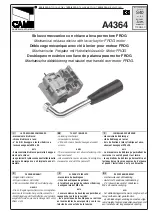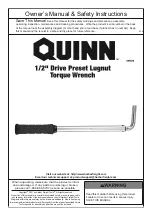
warnInG:
People with pacemakers should consult their physician(s) before using this product.
Operations of
electrical equipment in close proximity to a heart pacemaker could cause interference or failure of the
pacemaker.
extensIOn cOrDs
1. as the distance from the supply outlet increases, you must use a heavier gauge extension cord.
Using extension cords with inadequately sized wire causes a serious drop in voltage, resulting in loss of
power and possible tool damage. (See table below)
2. the smaller the gauge number of the wire, the greater the capacity of the cord.
For example, a 14
gauge cord can carry a higher current than a 16 gauge cord. (See table below)
3. when using more than one extension cord to make up the total length, make sure each cord
contains at least the minimum wire size required.
(See table below)
4. If you are using an extension cord for more than one tool, add the nameplate amperes and use the
sum to determine the required minimum cord size.
5. If you are using an extension cord outdoors, make sure it is marked with the suffix “w-a” (“w” in
canada) to indicate it is acceptable for outdoor use.
6. make sure your extension cord is properly wired and in good electrical condition.
Always replace a
damaged extension cord or have it repaired by a qualified electrician before using it.
7. Protect your extension cords from sharp objects, excessive heat, and damp or wet areas.
recommended minimum wire Gauge for 120 volt extension cords
Nameplate Amperes
(at full load)
Extension Cord Length
25 Feet
50 Feet
75 Feet
100 Feet
150 Feet
0 - 2.0
18
18
18
18
16
2.1 - 3.4
18
18
18
16
14
3.5 - 6.0
18
18
16
14
12
6.1 -7.0
18
16
14
12
12
7.1 -12.0
16
14
12
10
X
12.1 - 16.0
14
12
10
X
X
16.1 - 20.0
12
10
X
X
X
X – Not recommended for use with extension cord.
opEration
1. following all safety requirements already listed, plug the poower cord into a circuit-breaker
protected 120v, 60Hz power outlet.
2. turn on the tool, making sure the blades are not in contact with the work piece.
To cut material,
move the tool slowly forward along the desired cut line of the material. As the center shear blade (1)
moves up and down against the side knife set (2) the material will be cut.
nOte:
make a few practice cuts on scrap material before cutting your work piece.
4. to stop cutting, let go of the switch (34).
Always unplug the tool after use.
warnInG:
the edge of sheet metal is very sharp.
Always wear protective gloves when handling sheet metal.
Do not cut across a welded seam as this might damage the blades.
During use, do not obstruct the motor vents in the cover (42).
Obstruction may cause the motor to
overheat during use, possibly damaging the tool.
for any technical questions, please call 1-800-665-8685
4
8257370






























